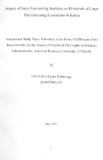| dc.description.abstract | The debate as to whether the accuracy of Sales Forecasting (SF) in large manufacturing companies improves when different forecasting methods are combined has continued to attract attention from scholars. Research in quantitative combination forecasting has been done extensively using seasonal and non-seasonal microeconomic, macroeconomic and demographic series, mainly in the United States of America. However, since organizations tend to also rely on qualitative or judgmental methods for their SF, it is unclear whether and how results from different forecasting approaches are actually combined by management in firms to improve forecasting accuracy and how any differences in combination strategies are reflected in forecast performance.
Despite the increased focus on forecasting, empirical research on forecasting still deals with methodological issues such as the development of more accurate forecasting methods. Whereas there, undoubtedly, have been some improvements in available methodologies, it is management’s knowledge and use of existing methods, in their specific organizational context, that holds the greatest promise (Makridakis et al. 1983, p. 13). Schultz’s (1992, p. 410) study paper underscores the fact that application issues are rather under-explored. The greatest gains in SF research are currently perceived to be in the areas of implementation and practice in firms. Little research exists in developing economies, like Kenya, in the area of combined SF strategies. This Independent Study Paper therefore, seeks to contribute to the knowledge in SF practices by developing a more accurate forecasting model through the assessment of how results from dillerent forecasting approaches are actually combined, in order to improve accuracy, and how any differences in combination strategies are reflected in forecast performance, while taking cognizance of the probable role of decision making processes, organizational structures and the external environment. Performance can be measured using financial and growth indicators, more specifically, revenue, profit, return on assets, return on sales, market share and earnings per share/dividend yield, where dividend yield is a specific output that shareholders are interested in. | en_US |



